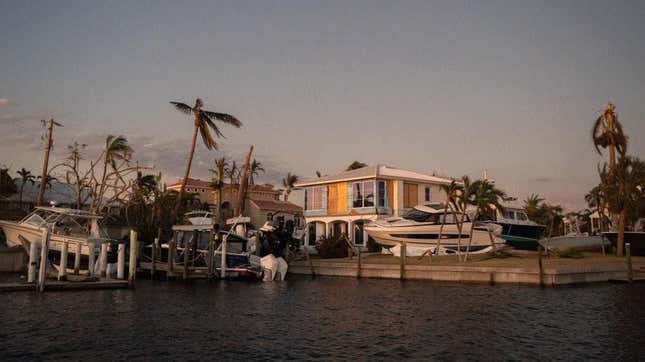
You might assume that home prices would decline in an area recently wrecked by a hurricane, but a new study finds the opposite is true, and post-storm price hikes could be a major driver of what’s known as climate gentrification.
The study, published in Journal of Environmental Economics and Management, found that home prices in Florida were 5% higher in the three-year period after a hurricane. Those hurricane-stricken housing markets attracted wealthier residents instead of scaring them away.
Researchers looked at hurricane data from NOAA, housing information on Zillow, and tax assessments in Florida from 2000 to 2016. “Using mortgage application data, we find that incoming homeowners in this period have higher incomes, leading to an overall shift toward wealthier groups,” the authors wrote in their abstract. This is a sign of climate gentrification, or when wealthier people move into area after an extreme weather event disrupts or displaces the existing community. Climate gentrification can also occur when wealthier people move into lower-income communities seeking relief from long-term climate issues like flooding.
The researchers estimated that the short-term price spike may come from the decrease in housing supply caused by storm damage. They also found that home prices do return to pre-hurricane levels but never go under that. During those three years where housing prices are higher, the wealthier buyers are the ones who can afford to purchase homes. By the time prices stabilize again, higher-income homeowners occupy about a quarter of the homes in storm-affected communities, the study found.
Yanjun (Penny) Liao, a fellow with the Resources for the Future, told E&E News that this might happen because wealthier property owners can afford to go through a disaster. “It’s not like their financial wealth is going to be wiped out if they have to pay to rebuild their home,” she said.
The state’s complicated insurance industry is one reason why wealthier people can continue to be homeowners or come in and buy properties after a storm. The industry wasn’t doing too hot even before Hurricane Ian made landfall last September. Several private insurance companies shut down in 2022, and more than 12 shuttered since 2020, Quartz reported. Property owners have had to turn to Citizens, the state-owned insurer. Because that insurer has taken on thousands of customers in the last two years, extreme weather would make it harder to pay out every property owner affected by extreme weather. And purchasing insurance is expensive in Florida. Homeowners in the sunshine state pay about $4,000 on average for insurance, compared to the national average of $1,544.
Depending on their insurance, Florida homeowners may struggle to address more complex storm damage, like mold. Some home insurance policies don’t cover mold, and property owners may have to purchase separate insurance that will cover those damages, according to Investopedia. Lower-income homeowners can’t handle the major repairs on their own.
According to Liao, researchers behind the study were surprised that housing demand doesn’t sharply decline after a storm hits, especially as climate change fuels stronger storms. “Our findings show that the idea that people will naturally retreat from hazardous areas may not necessarily hold up,” she said in a press release. “In Florida, at least, it appears that market forces are not encouraging people to move to safer places.”
The researchers hope that the study will lead to more examination of how post-hurricane housing markets affect lower-income home buyers and longtime renters. “Policies may be needed to ensure that these communities have strong adaptation and mitigation measures in place to deal with future storms,” coauthor Joshua Graff Zivin of the University of California San Diego said in a statement.